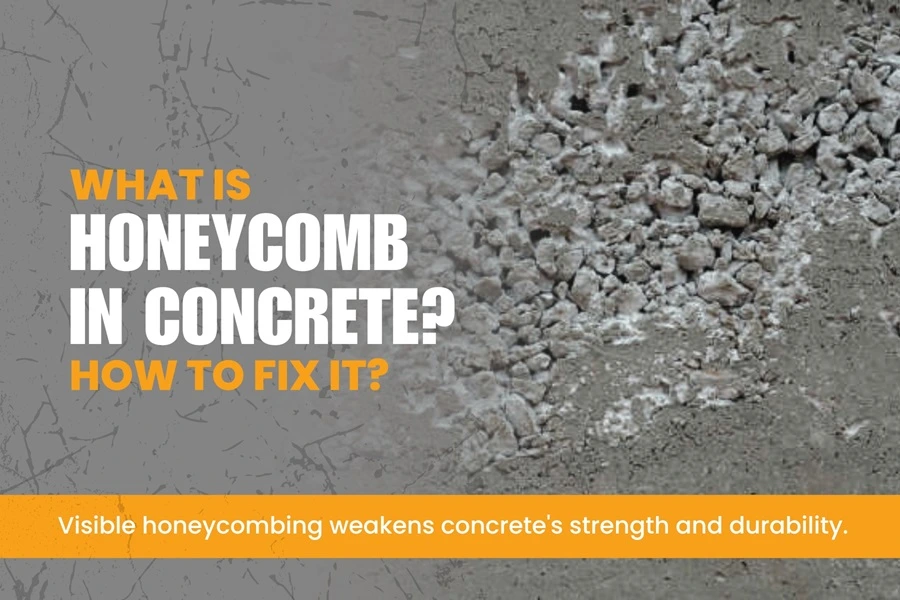Concrete is an essential building material worldwide, thanks to its incredible aesthetic and strength. However, the strength of concrete can be affected with the formation of honeycomb in concrete. Besides deteriorating the overall compressive strength of the concrete, honeycomb also affects the visual appeal of the structure. This can also have detrimental effects on the durability of the building.
Table of Contents
In this blog, we will learn everything about honeycomb in concrete, including its types, causes, and prevention methods. Read the blog to know all you need to know about honeycomb forming in concrete structures.
What is Honeycomb in Concrete?
Honeycomb is the formation of small gaps and hollow cavities that can sometimes form on the concrete’s surface or within the slab. These spaces develop due to the presence of air bubbles when the poured concrete is unable to fill small spaces around the steel framework, or due to rough aggregate material.
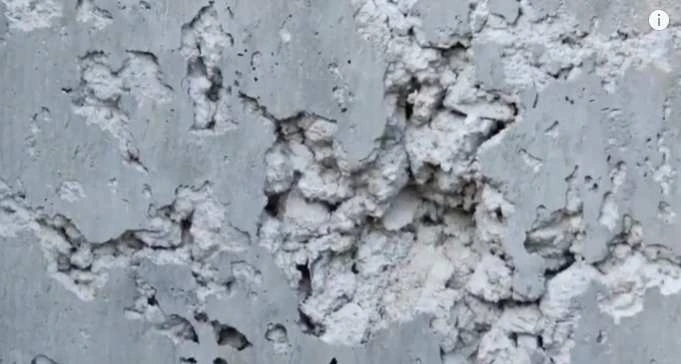
The gaps and cavities are interconnected and resemble a honeybee’s nest. Honeycomb can develop in various types of concrete structures, such as slabs, beams, columns, walls, and steps. This defect in the concrete becomes noticeable as soon as the framework is removed.
Such defects can affect the inherent strength and durability of the concrete, and also weakens the supporting reinforcements significantly. The defect can cause air, water and chemical penetration into the concrete structure, which has a corrosive effect.
Honeycomb in concrete also lowers the structural durability of concrete parts in a building, which can affect its overall load-bearing capacity. This defect is highly concerning and common in coastal areas where buildings are constantly exposed to moist air and humid climate.
What causes honeycomb in concrete?
There are several factors that can cause honeycomb in concrete. Some of the major causes for forming of honeycomb defects in concrete are –
Incorrect concrete mixing
Inappropriate mixing of concrete is a main cause for formation of honeycomb in cemented structures.
Improper compaction
Improper compacting of concrete can cause air bubbles to develop within it, which is often the result of insufficient vibration during the placement of concrete.
Poor grade aggregates
Using poor-quality cement aggregates can also result in formation of tiny voids and cavities in the poured concrete.
Excess water-cement ratio
It is highly recommended to measure the water-to-cement ratio carefully when mixing concrete, as surplus water-cement proportions can cause honeycomb-like defects to develop in the concrete after it is poured.
Framework problems
At times, poorly designed framework can also cause concrete to develop honeycomb defects. For instance, this defect can develop when the concrete does not fit correctly, or has not been properly sealed.
Types of honeycomb in concrete
Honeycomb effect in concrete occurs when small cavities or significant gaps develop in the poured concrete structure. This can be due to insufficient compaction, or incompletely filling of the framework. This defect can be seen the following sizes –
Small honeycombs
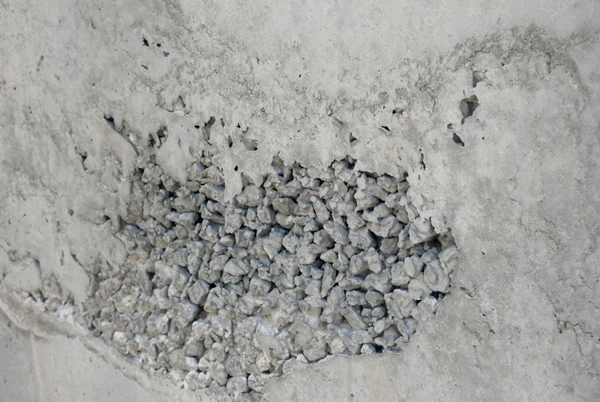
Small honeycomb defects in concrete usually have gaps that are less than 10 mm in size. These are usually caused due to surface irregularities, or minor voids remaining in the concrete after placing and compacting the concrete. The small-sized honeycomb defects do not necessarily pose a threat to the structure’s integrity but their effects can damage the aesthetics of the concrete surface.
Medium honeycombs
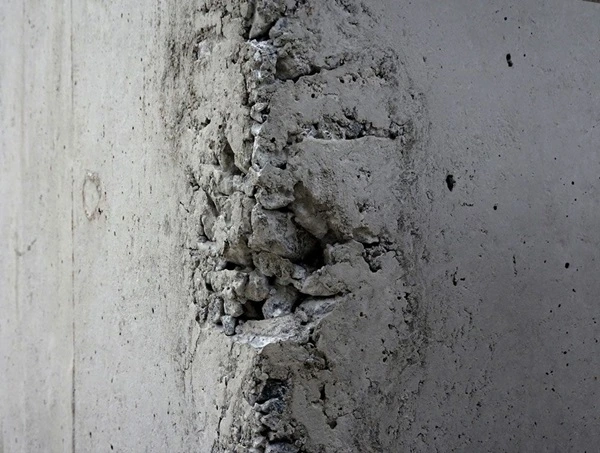
Mid-sized honeycomb defects normally range around 10 mm to 50 mm in diameter. These defects can arise from insufficient vibration when compacting is done, and even with poorly installed framework. Medium-sized honeycomb defects in concrete can affect its durability and overall strength.
Large honeycombs
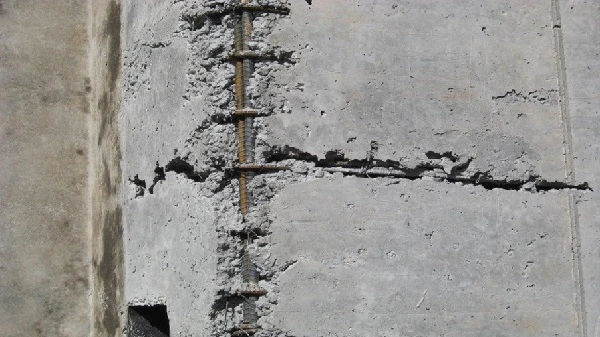
Large-sized honeycombs in concrete are over 50 mm in diameter, and are usually caused by improper placement, irregular framework, or from not removing dust and debris from pouring concrete. Larger honeycomb defects significantly deteriorate the inherent strength and durability of the concrete structure.
How can you prevent honeycomb in concrete?
Now that you know the types and causes of honeycomb in concrete, let’s find out how to avoid these structural defects–
- Fall height of concrete should be the minimum to ensure the concrete is completely compacted on pouring.
- Do not delay or segregate the concrete when it is being placed.
- Make sure to use the best-quality concrete mix which contains the ideal portion of fine aggregate particles.
- Ensure cover block is sufficient over freshly concreted surfaces.
- Make sure to compact the concrete sufficiently once it is poured in place.
- Follow instructions provided by manufacturers to use concrete for best possible results.
- Make sure to provide sufficient vibration to concrete after pouring, and avoid formation of gaps and voids within the concrete.
Conclusion
Overall, honeycomb in concrete is a major concern for builders and homeowners all over the world. These are usually small defects that occur from improper mixing, inappropriate pouring, and insufficient vibration for compacting the poured concrete.
There are several ways to avoid the formation of such defects in concrete, such as ensuring proper-fitting framework, choosing high-quality concrete admixtures, from Sakshi Chem Sciences, and following the manufacturers’ instructions, for best results.
FAQs
Is honeycomb good for concrete?
No, honeycomb in concrete is not good, as it can lower the overall strength and durability of the concrete structure.
How do you fix honeycomb in concrete?
Grouting is the best way to fix honeycomb defects that develop in freshly-poured concrete. Use a grout pump to fill tiny gaps and small gaps in the structure. However, you will need to use more extensive repair methods to fix larger-sized honeycomb in concrete.
How much honeycomb is acceptable in concrete?
There is no specific limit for allowing honeycombing to occur in concrete. It is strongly advised to keep the honeycomb effect to the minimum, if it cannot be avoided altogether, to ensure the structural integrity and overall strength of the concrete building.
What are the disadvantages of honeycomb concrete?
Major disadvantages and drawbacks of honeycomb in concrete are higher risk of water seeping into reinforcements, lowered load-bearing capacity, corrosion and rusting, and damage to the structural integrity.

